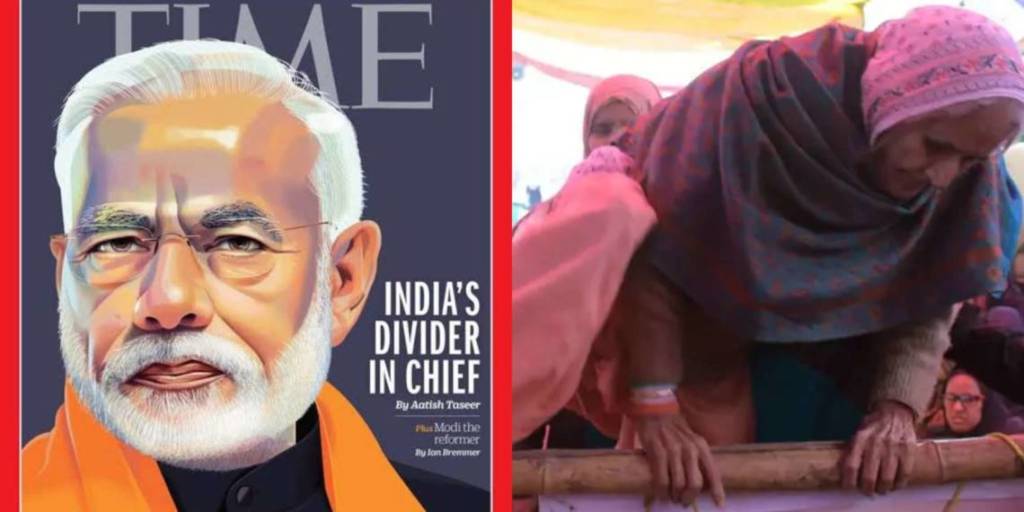TIME Magazine has released its 2020 list for the 100 most influential people around the world. Apart from a highly distorted, biased and fallacious representation of Prime Minister Narendra Modi in this year’s list, penned by a blatant Modi-hater, the magazine previously known for calling India’s Prime Minister a ‘Divider-in-Chief’ has also included a name which nobody in India is aware of, but which TIME Magazine thinks is a globally influential personality. The name of 82-year old Bilkis also referred to as the ‘Dadi’ of Shaheen Bagh features in the list.
It was Biklis ‘Dadi’ who, on December 15 last year, along with 50 other women had begun their protest against the Citizenship Amendment Act (CAA) by blocking road 13A in Shaheen Bagh, which had caused a four-month-long hassle to commuters between Delhi and Noida. For Bilkis Dadi, the compendium was written by Rana Ayyub, and therefore, while Narendra Modi is portrayed as no less than the devil incarnate himself, Bilkis Dadi on the other hand is shown as someone who Indians take inspiration from, even as nobody outside Northeast Delhi has heard of her.
TIME Magazine conveniently evades the fact that the Shaheen Bagh protest site was used for inciting and planning the anti-Hindu Delhi riots which rocked the national capital in late February this year. The entire ‘movement’ of Shaheen Bagh was premised on a grand lie – that of the Modi government working towards disenfranchising Indian Muslims and throwing them out of the country. A blatantly hateful Islamist movement; Shaheen Bagh was made to look like a protest led by Muslim-women, which was a flagrant charade put up to ensure that the authorities find it difficult to clear the arterial road.
What TIME Magazine also forgets is that while the Shaheen Bagh protest, whose symbol the India-hating publication thinks is Bilkis, was an anti-government protest, it was also a sit-in used by anti-India elements to plot violence against the majority community – Hindus. Former AAP Councillor Tahir Hussain, who masterminded the protests and subsequent riots in association with Umar Khalid, Sharjeel Imam, Safoora Zargar and other Islamists, while having the monetary assistance of organisations like PFI, has himself admitted to orchestrating the riots, born out of Shaheen Bagh, in order to teach Hindus of Delhi a lesson.
It is no secret that international media organisations work with an explicit anti-India agenda in the back of their minds, which is why they end up making foolish mistakes such as the listing of 82-year old Bilkis as the most influential personality of 2020. In cahoots with India-hating intellectuals from the country, who Western media outlets think represent all of India, publications such as TIME push through a laughably squinted view of all that is happening in the country. They also end up falling for the antics of liberal and sold-out portals within India, who have gone about equating the paid protests at Shaheen Bagh as a great and spontaneous public movement, such as that which was seen after the Nirbhaya gangrape case.
The listing of ‘Dadi’ is a forced move, aimed at marketing the protests and protestors as those driven by a legitimate cause. This is dishonesty at its peak, as neither does ‘Dadi’, nor any other protestor of Shaheen Bagh have any influence in India, leave alone around the world. This is also a move aimed at concealing the names of the real organisers of the protests, who ironically have also been found to be conspirators and orchestrators of the anti-Hindu riots which broke out as a result of the extremist narratives pushed out from the protest site at Shaheen Bagh for three long months.
TIME Magazine’s hit jobs on India have hit a new low, and dishonesty of such magnitude should be worrying for not just Indians, but also readers of the publication across the world. The Shaheen Bagh protests were nothing more than an outlet for Islamists to vent out their frustration against India and Hindus. The protests have lost steam, but we must always remember that they culminated only after the Northeast Delhi riots were orchestrated.
